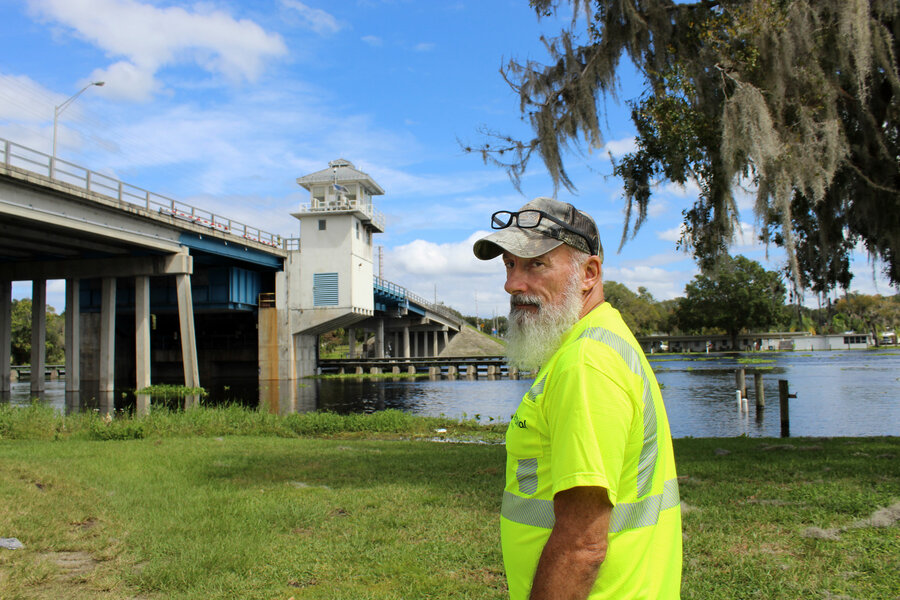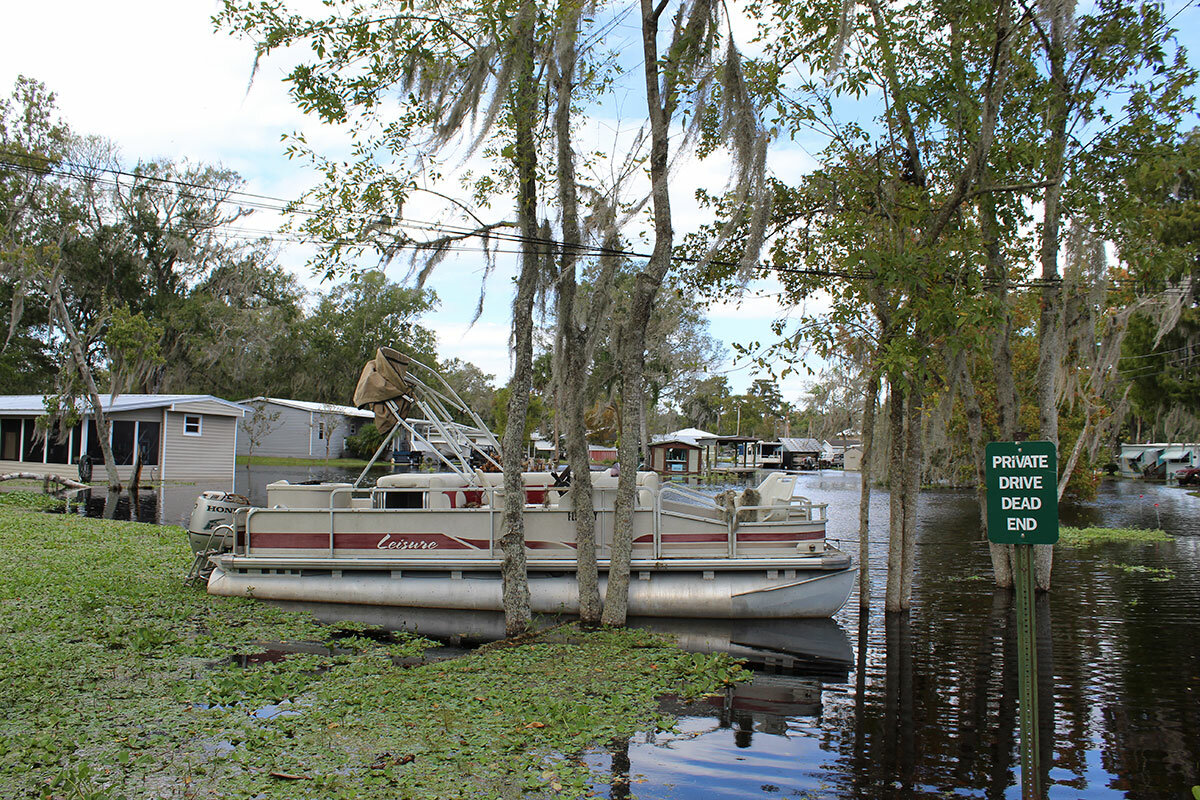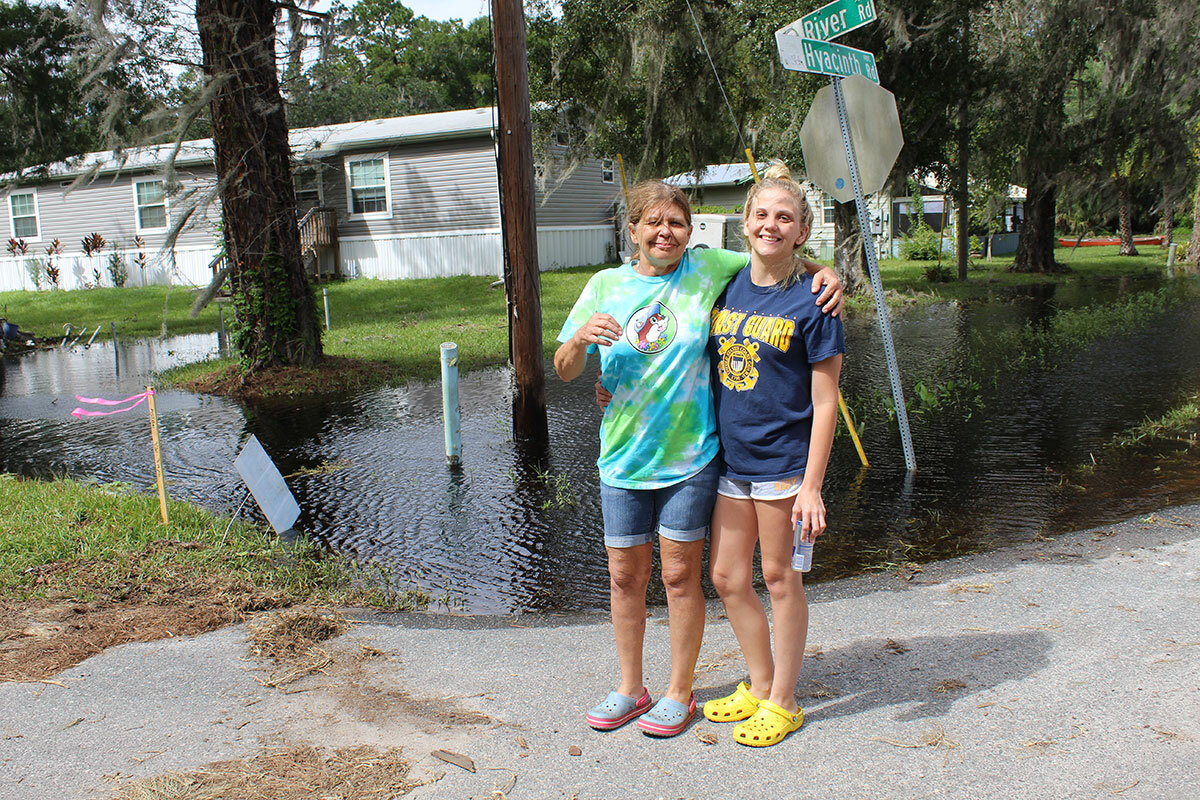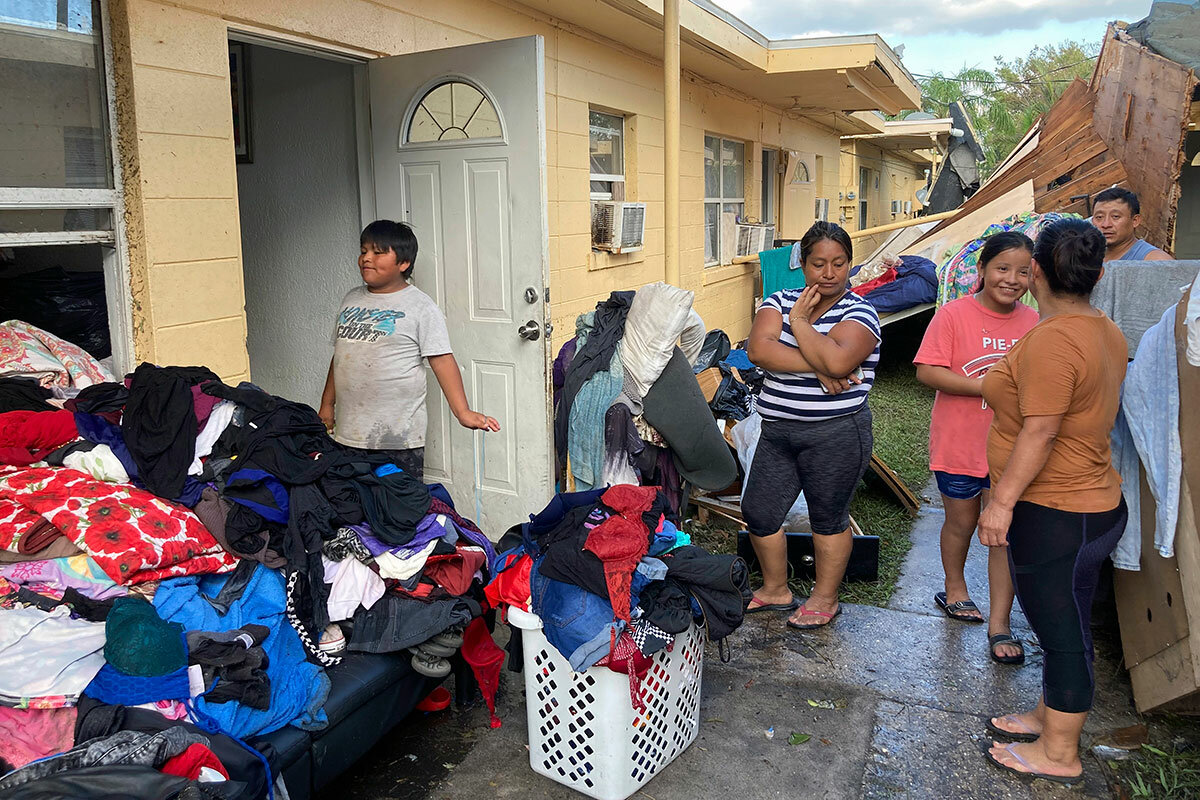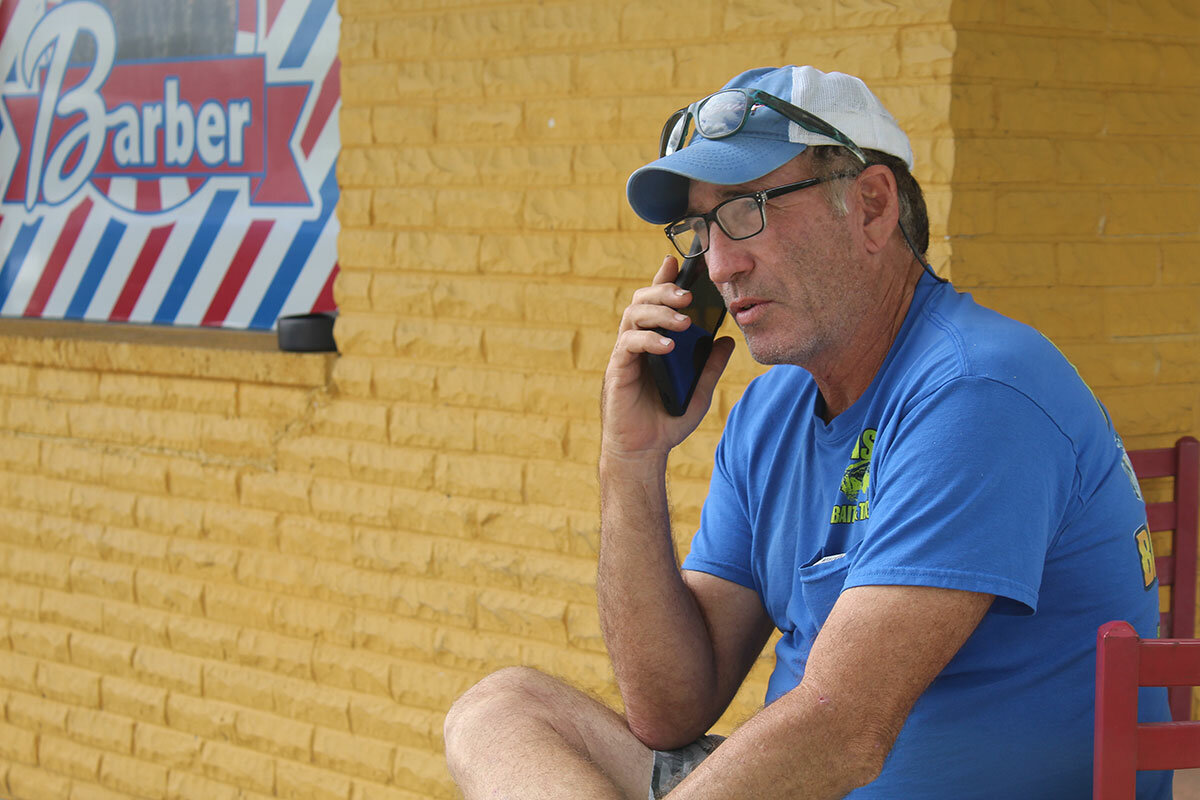After Hurricane Ian, floods leave a deep insurance gap
Loading...
| ASTOR, Fla.
Fuss Johnson was born in Daytona, Florida, grew up in North Carolina, and then returned to the Sunshine State with his family as a teenager. He once tried living in California. He caught the first ride back.
“It’s hard to imagine being anywhere else,” says Mr. Johnson, who is now in his 50s. “Florida’s home.”
A home, he says, that is now sitting in water. Days after Hurricane Ian slammed into Florida’s Gulf Coast, killing over 100 people and leaving vast fields of wreckage, water from the storm’s massive rainfall is still inundating the great peninsula’s palmetto-dotted interior.
Why We Wrote This
A story focused onWith great risk comes great responsibility. Florida is facing a reckoning over rising insurance costs, shifting storm patterns, and who pays to put the state’s homeowners back on their feet.
The Peace River near North Port is still turning yards into ponds. Clear Water Lake in Apopka has continued to rise. People are trudging in and out of sodden apartment buildings in Orange County – the seat of Disney.
And here in Astor, where Mr. Johnson is the bridge mechanic for the single-span Astor Bridge, the St. Johns River was still severely flooded on Tuesday, leaving hundreds of homes with water in them and residents wandering around in disbelief.
America’s premier state of dreams is in a state of flux.
Hurricane Ian’s winds and floods have put a spotlight on how bigger and wetter storms create new risk in a state where unique geography intersects with fast-paced development. With everything from manufactured homes to million-dollar waterfront condos in harm’s way – from storm-wrecked Sanibel Island to the backyard docks of River Road, here in Astor – the storm leaves major insurance questions in its wake.
Legions of Floridians have uninsured properties. Florida’s singular political and legal culture has resulted in a strained marketplace for those who do have insurance. The aftermath of Ian could lead to a reordering of personal and communal responsibilities here in one of the most dynamic weather states in the U.S.
“We were already in crisis before this storm, and we will certainly be in full collapse after this storm,” says Ray Lehmann, editor-in-chief of International Center for Law & Economics. “If you look at the history of Florida, going all the way back to [the founding of] St. Augustine, it exists as a long series of speculative real estate bubbles. At some point the gravy train is going to stop. We’re getting there.”
One indicator of trouble: In counties where residents were asked to evacuate, only about 18% of homes have coverage through the federally backed National Flood Insurance Program. Mr. Johnson has it, but many of his neighbors do not.
That sobering statistic shows the broader challenge facing how America rebuilds after disasters. Strain is only growing on the mix of private and public dollars that prop up storm-damaged areas.
Here in Florida, especially after Ian, it could be called a full-blown insurance crisis.
Unlike any other state, Florida’s insurance market is populated, as a feature of Florida law, by mom-and-pop insurance companies that write only property insurance. Auto and boat premiums drive profits at most insurance firms. Some of those smaller companies are struggling.
“We have thinly capitalized, very undiversified domestic insurers, six of whom have been declared insolvent in the last year and two dozen more that stand ready to be downgraded” by a rating agency, says Mr. Lehmann, in Tampa.
That has left Citizens Property Insurance Corp., a state-backed firm headquartered on Bay Street in Jacksonville, as an insurer of last resort. Its market share is growing fast, even as its risks are as well.
The community of Astor is named for the wealthy New York family dynasty, which once owned most of this crook in the St. Johns River. Today, it is part of northern Lake County, where double-wide trailers are squeezed together around boat-filled canals. Flags fly everywhere on front-yard flagpoles. There are Trump 2020 flags not far from one with the profile of a lumbering sasquatch holding a fishing pole.
Stephanie Fletcher and her mother, Michelle Fletcher, live next door to each other just outside the reach of Tuesday’s crest. Ms. Fletcher’s home sits 10 feet above her daughter’s – the result of newer construction and updated county flood codes. “We stayed dry. We were lucky,” she says.
But down the street, things are more difficult. The Fletchers have rescued neighbors and confronted gawkers driving too fast through the floodwaters. On Tuesday, Lake County sheriff’s deputies investigated a report of a man who drew a gun on residents after they confronted him about his speed.
Before the storm, Ms. Fletcher says her insurance had “gone through the roof.” She expects more hikes now. As if to punctuate her point, an insurance adjuster – identified by a buttoned-up shirt and new truck, stepladder jutting out of the bed – drives through the flood, only to be turned back by the water.
Wading through her flooded garage, the younger Ms. Fletcher brags about her “indoor swimming pool.”
Days after the deadliest Florida storm since 1935, such gallows humor was tempered by a rising sense, for some, of running out of rope.
Nearby, Alan “Jake” Jacobson sat outside his bait shop, reassuring an older Kentucky relative on the phone that his octogenarian mother was OK after taking a fall while she was being evacuated from her Alice Drive home.
“I just put $60,000 into my home. I had it on the market for over $300,000,” he says. “Just before the storm, I took it off the market. I couldn’t decide whether I wanted to sell. And now it’s underwater – in more ways than one.”
“People don’t realize that we’ve never ... seen this amount of flooding where the rivers [are] overflowing,” says Susan MacManus, a University of South Florida professor emerita in political science who lives in Lutz, Florida. “People tend to only look at the ocean and the Gulf, so that’s really wreaked havoc in places that aren’t used to having water come 2 to 3 feet into their homes.”
In North Port, flooding continued as watershed managers tried to keep reservoir outflows tightened down. In Harlem Heights, a mostly Hispanic area where the annual median household income is $26,000, flooded residents fretted over how to recover from a just-receded flood.
“A lot of [newcomers] don’t realize they are putting themselves at risk by moving [to Florida], and not just along the coast,” says Mark Hafen, a former member of the Tampa Bay Climate Advisory Council.
Hurricane Ian’s total cost may exceed Hurricane Irma’s in 2017, which by some estimates left $77 billion in damages.
As other insurance firms struggle, state-backed Citizens Property Insurance now writes over 1 million policies, nearly double what it wrote a few years ago. Insurance rates have skyrocketed as housing values and risks rise. Florida is also a victim of its own laws around litigation. While the state has about 9% of national property insurance claims, it sees over two-thirds of all insurance lawsuits.
One oft-used strategy is for contractors to offer residents free roof repair – by making a claim to their insurer. When the insurance company balks at the high price or necessity, the contractor’s lawyer sues. The insurer usually settles – at a loss.
Of course, insurers could seek to raise premiums, but the state’s insurance commission has been trying to go in the other direction. Raising rates is a tough sell in a state where the middle class is being squeezed by rising housing costs. Floridians already pay triple the national average for property premiums.
“There is very little political will to do the things that need to be done,” says Mr. Lehmann. “I’m sure we will start hearing calls that we need a federal catastrophe fund” to shore up insurers, “but the major problem with that is that it benefits no other state.”
Over 20% of Floridians are over age 65, and thus often on fixed incomes like Social Security. As costs rise, letting insurance lapse is an inevitable outcome for many.
“Florida is growing so fast, and what happens is [that as] the value of property goes up, ... insurance costs go up,” says Dr. MacManus. “When people can’t afford insurance, they give it up, so you have all these uninsured parcels. Then when something happens, the person who owns the property has to get help from state and local and [federal] authorities. It’s an abundance of riches in some ways and a real pressure point on the poor.”
To be sure, Florida, which takes the most hurricane hits of any U.S. state, has worked to keep claims down. It has some of the strongest wind-resistance codes in the United States. It has worked to make communities more flood-resistant. It has revamped insurance regulations, though it’s unclear whether the Legislature has gone far enough to discourage frivolous litigation. The state has a strong economy. It is the fourth-largest in the U.S., at $1.2 trillion in annual output. Finance, insurance, real estate, rental, and leasing are the state’s largest economic sectors.
Those efforts and assets are now being tested by the sheer magnitude of Hurricane Ian, and promises of storms that are larger, wetter, and more powerful as a result of rising air and sea temperatures.
“It’s hard to gauge the true flood risk ... so that exposure coupled with intensive development is a real recipe for disaster,” says Gavin Smith, a disaster resilience expert at North Carolina State University in Raleigh. “The question is, to what extent is the state or even insurance companies thinking about incentivizing more risk-reduction measures? Are they going to take it to the next level? And who pays for it?”
The industry is testing new methods of adjustment, including using mapping technology to determine premiums and claim awards. Using individual structures instead of zoned areas to set premiums is one possible solution.
Questions around who shores up the broken insurance market may also be answered politically, says Dr. MacManus. Democrats, she says, are already linking property insurance issues and climate change to activate two key pools of voters: the younger and the older.
The heart of the issue, she adds, isn’t necessarily political, but the unique bonds many Americans have to Florida, even if they don’t live there.
“Often, properties have been passed on, some little place that’s not a palace but it’s a Florida retreat, loved by family and enjoyed by family,” says Dr. MacManus. “Now the family is going to have to make some decisions.”
Mr. Jacobson here in Astor is at that point. Lacking flood insurance, he expects to receive some FEMA funds to help get his home livable again. It was the second time in five years he was hit by a flood that experts called once-in-a-century events.
That fact weighs on him as he fills out paperwork and ponders the new burdens on his checkbook.
“The risk is growing,” he says. “You start to realize you are taking your chances.”
Editor's note: The second photo caption in this story has been corrected. The river in Astor, Florida, flows northward.




